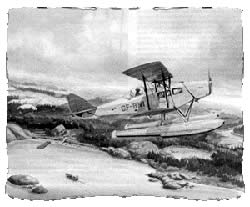|
Northern Vignettes
Arctic Harpoons
Beechey Island
Crystal II
Deline/Fort Franklin
Fort Hope
Fox Moth
Kellet's Storehouse
Naujan
Old Fort Providence
Old Fort Reliance
Stone Church
Thule Village
Yellowknife
Fort Journal
|
The Fox Moth was only one of a number of "Moth"
designs produced by Geoffrey deHavilland In 1977, a local Yellowknifer initiated the concept of restoring a Fox Moth to its original condition using parts from various known crash sites. Although there were some sceptics, the idea soon caught on. With the assistance of Aero Arctic Helicopters and the Government of the Northwest Territories, parts of the aircraft were retrieved from three crash sites - the project was under way. Written by Wally Wolfe and published in "Arctic" Volume 42, Number 1 pp.82-84 |
 The
deHavilland Fox Moth is probably not as well known in northern aviation
history as the Fokker Universal, the Fairchild or the Norseman of
its time or, indeed, the highly successful deHavilland Beavers and
Otters that followed. Nevertheless, it is a part of northern aviation
history, providing transportation and supply links that contributed
to the post-World War II development of the North.
The
deHavilland Fox Moth is probably not as well known in northern aviation
history as the Fokker Universal, the Fairchild or the Norseman of
its time or, indeed, the highly successful deHavilland Beavers and
Otters that followed. Nevertheless, it is a part of northern aviation
history, providing transportation and supply links that contributed
to the post-World War II development of the North. of
Great Britain after World War I. It was a combination of the Tiger
and Puss Moths.
of
Great Britain after World War I. It was a combination of the Tiger
and Puss Moths.